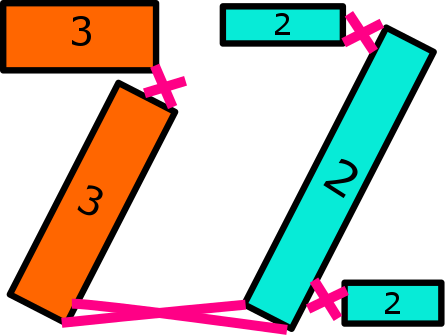Why 1 is not a prime number

Hi Steemicians! Today we will be covering a question from @isa93 on this post over here. Her question concerns prime numbers. Prime numbers are numbers greater than one whose only divisors are 1 or itself (a divisor of a number n is a number k such that n/k is a whole number). So 3,5,7 are examples of primes. @isa93 her (rephrased) question is
This question is connected to a fundamental result of number theory which gives the building blocks of the whole numbers. We will start with this fundamental result and then work back to the question.
The Fundamental Theorem of Arithmetic
The fundamental theorem of arithmetic is a result that answers the question how can you construct whole numbers? This brings us to the question what does construct mean in a mathematical sense? Construction of a number is always in relation to a mathematical operation. Mathematical operations are in this case operations on numbers, so for example addition, multiplication. It is easy to see that if you use the number 1 and addition then you can construct any whole number. For example we have that 5=1+1+1+1+1. So constructing any number with addition is easy. How about if I can only multiply? Now it is time to introduce the fundamental theorem of arithmetic:
Fundamental Theorem of Arithmetic. Every whole number is either a prime or can be written uniquely (up to re- ordering) as primes multiplied by each other
Let us explain this with an example: 24=2 x 2 x 2 x 2 x 3. Observe that 2,3 are prime numbers. The written uniquely (up to re-ordering)-part in the theorem means that we consider 2 x 2 x 2 x 2 x 3 and 3 x 2 x 2 x 2 x 2 the same. So for this case the theorem says that I always need to multiply the same prime numbers the same amount of times to get 24. Here is another example: 72=3 x 3 x 2 x 2 x 2

Informally the theorem says that the prime numbers form the unique building blocks of any whole number under multiplication.
Fundamental Theorem of Arithmetic fails when 1 is prime
So now we get back to the question of @isa93. Suppose for a moment that 1 would be considered a prime number. Let us check whether the fundamental theorem of arithmetic still can be true. Again we look at 24. Then 24= 2 x 2 x 2 x 3=1 x 2 x 2 x 2 x 2 x 3 =1 x 1 x 2 x 2 x 2 x 2 x 3, because we considered 1 a prime the fundamental theorem of arithmetic cannot be true anymore! So because we want the fundamental theorem of arithmetic to be true we define primes such that 1 is not a prime. This seems a bit like cheating....
The relation between definition and theorem
In mathematics you define stuff so that that you can prove awesome things for the stuff that you defined. Sometimes the stuff that you define comes very natural but other times you need to adapt the stuff you define so that you can prove something for it. Of course you can also relate this to real-life things. I can only enjoy drinking a beer if I remove the beercap ;). So that is pretty much the relation between prime numbers and the fundamental theorem of arithmetic. You can only enjoy using the fundamental theorem of arithmetic if you remove 1 from the prime numbers.
Sources & further reading
Today everyhing is completely original. But if you are interested in a proof of the fundamental theorem of arithmetic you can take a look over here
All figures made using Inkscape it is free to use!
Thank you!
Thanks for being so kind to read my post. You are awesome! Please follow me if you enjoyed it. If you have any questions just post them below and I will answer them. Or if you might have a nice topic you want me to cover also let me know below :o)

@originalworks
That was quick hahaha thanks for clarifying.
...If you reeeeally are looking for topics to cover, could you get into epsilon-delta limits definition? Like, demonstrations using that definition. Always caught my attention but never really dug into it to wrap my mind around it.
If not that, maybe math problem resolution methods? That's always interesting and really fun to read about :)
WoW! I had to google that one, just to confirm again that non-english may have different terminology and can easily be Lost In Translation. :)
Maybe resolution = problem solving. I am not a mathematician tho, and really "hated it" at all my university years, but as the years pass I am loving it more and more... I constructed this sentence so nice to come up with this quote from Ender's Game :)
Almost forgot to mention, you nailed the article/text/post once again! :) Keep them coming :)
Oooh shoot, you're right sorry! Indeed I meant problem solving covers her eyes. Thanks!
Everything is cool :) As a non-native English speaker I miss the translation too :)
Cheers!
Thankies.
Well most relationships are love-hate. I also hate math somedays only to realize that I love it the next day.
Also thanks for reminding me that I still haven't read Ender's Game ;)
I’m able to explaine the limit definition, but it is pretty hard for me in English. By the way there are different definitions for limits and there are different kinds of limits. For example you can define it for real numbers or complex numbers (or even in other algebraic structures). Same goes for prime numbers there are algebraic structures there you can’t use the theorem of this article.
What do you mean with solution or solving problem? Solution methods for polynomial equations?
Yes you are right, the fundamental theorem of arithmetic belongs to the more general theory of (unique) factorization (over fields). I guess the easiest way to explain this is using polynomials.
I am currently thinking what the easiest way is to explain epsilon delta continuity definition using geometrical concepts as opposed to analytical ones. The latter is what you always find in calculus books but I think it is not the best way of explaining it.
I am not sure if I ever have heard about resolutions methods :O
What is a resolution method?
Congratulations! This post has been upvoted from the communal account, @minnowsupport, by MathOwl from the Minnow Support Project. It's a witness project run by aggroed, ausbitbank, teamsteem, theprophet0, someguy123, neoxian, followbtcnews, and netuoso. The goal is to help Steemit grow by supporting Minnows. Please find us at the Peace, Abundance, and Liberty Network (PALnet) Discord Channel. It's a completely public and open space to all members of the Steemit community who voluntarily choose to be there.
If you would like to delegate to the Minnow Support Project you can do so by clicking on the following links: 50SP, 100SP, 250SP, 500SP, 1000SP, 5000SP.
Be sure to leave at least 50SP undelegated on your account.